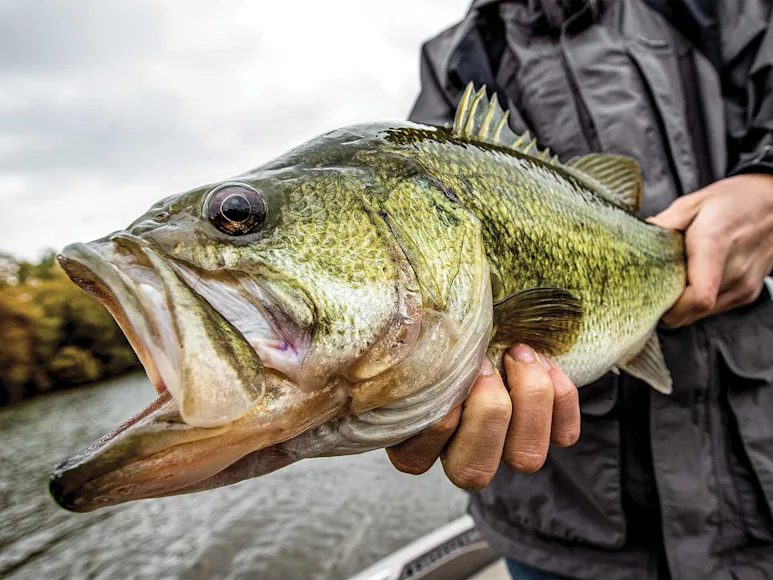_We may earn revenue from the products available on this page and participate in affiliate programs. Learn more ›
_

Just about every predator species on the planet will smack a spoon. Gregory Reid
Pay attention to trends in fishing tackle, and you’ll notice that among lure-makers, there is a constant competition to improve upon what has already been working for many years. These days we have spinnerbaits with rattling crystal balls instead of blades. We have plastic worms that reflect UV light. And while they’re more gimmicks than anything (for now, at least), we even have hard baits that swim by themselves thanks to their computer guts. What you rarely see anyone trying to improve upon—beyond perhaps paint jobs and glitz—is the spoon. The reason is simple: There isn’t really anything to reinvent, and it certainly ain’t broke.
Since Lou Eppinger finalized the spoon that would eventually become the Dardevle in 1912, the basic design hasn’t changed. It’s a simple, tapered slab of metal with a hook. Sure, the sizes, weights, and exact shapes vary, but no one has devised a spoon so revolutionary that it makes Eppinger’s classic design obsolete. Ironically, it’s probably the lack of “new” in the spoon category that keeps many modern anglers from using them, and that’s a huge mistake.
Spoons are about as versatile a lure as you’ll find. All you have to do is cast, reel, and catch. You can also make a spoon presentation as technical as you might when using the latest Japanese soft-plastic finesse rig. Spoons will trigger any predator species that swims in salt or fresh water the world over. They can be trolled, cast, jigged, or swung to work in any part of the water column. Provided you don’t lose it, a single spoon can catch decades’ worth of fish.
There certainly isn’t a wrong time of year to tie on a spoon, but the time is just a little more right in the fall. Cooling waters often get baitfish schooling from the striper coast to the bass lake. In river systems, the temperature drop signals trout and pike to chew before winter. Whether you need to imitate a perch or herring, shiner or shad, there’s a spoon that will nail it.
Here are six can’t-miss models and the tricks that I and some of the best guides and pros around the country use to make them work for us in autumn.
Jenko Sticky Spoon – Target: Largemouth Bass

Bass will hammer spoons in the fall. Tom Martineau / The Raw Spirit
At 8 inches long, Jenko’s Sticky Spoon seems like it would be at home in a saltwater striper box, perhaps even being trolled on sinking wire line. But make no mistake, this big hunk of metal was designed for largemouths, and it’s a back-pocket ringer for bass pro and company owner Coleton Jennings. It shines particularly on his home waters at Kentucky Lake in the late season, but Jennings is quick to point out that the Sticky Spoon is not a numbers lure.
“This spoon is something I always have in my rotation from September through November, but it’s not a lure I’ll be throwing all day,” he says. “You’re only going to get a couple of bites on it, but when you get them, they’re going to be big bites.”

A Jenko Sticky Spoon is deadly on bass. Gregory Reid
Kentucky Lake is often drawn down in the fall, so shad and schooling bass tend to congregate in deeper water around boat docks and bridge pilings. Jennings fishes his spoon on a 7-foot-6-inch heavy-action baitcasting rod matched with a high-speed reel spooled with 25-pound fluorocarbon. He notes that you can’t cast the Sticky Spoon far, so the game is getting close to the targets and flipping or dropping it vertically. The bite is going to come on the fall as the spoon wobbles and flutters. Jennings says maybe only two or three fish in a school will make a move on this large offering, but they’re going to be heavy hitters.
“When you feel that tick, you don’t want to swing hard,” Jennings says. “You just want to stiffen up, lean in, and reel as fast as you can. Because you’re so close to the fish, there’s no long fight. You’re just going to be swinging that big bass into the boat seconds after the hit.”
Eppinger Dardevle Five of Diamonds – Target: Pike
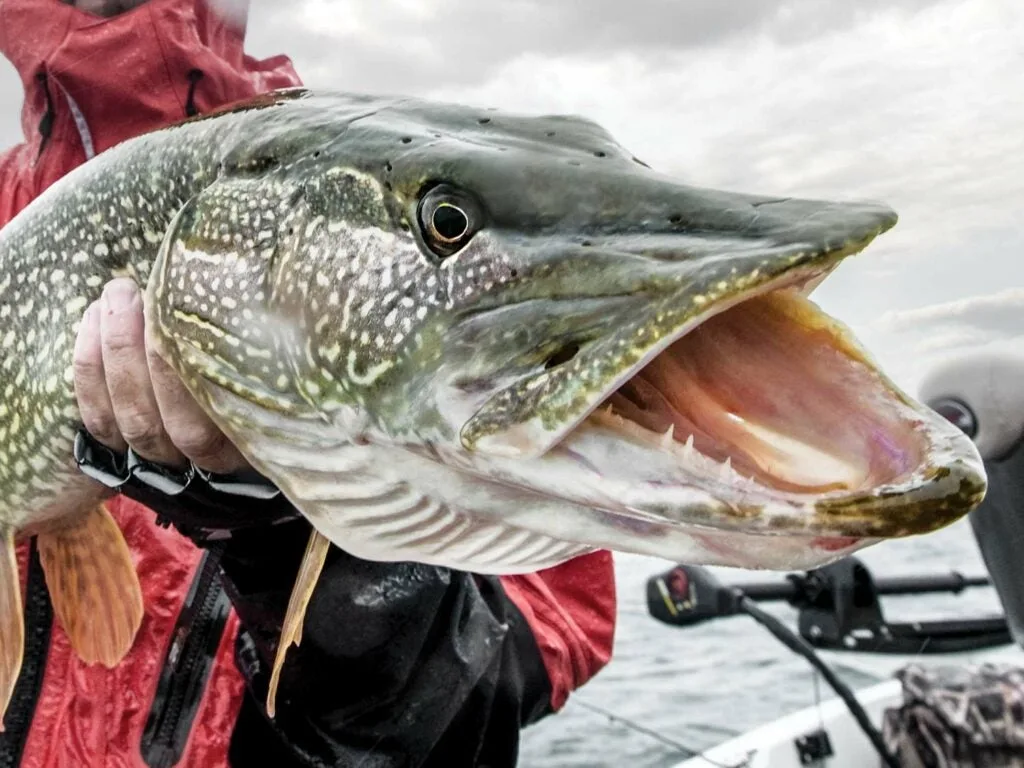
Target pike with Dardevle spoons. Lee Thomas Kjos/The Raw Spirit
The first time I ever experienced the potency of a Dardevle in the yellow-and-red five-of-diamonds pattern was at Cree River Lodge in northern Saskatchewan back in 2014. Everyone has known for decades that Dardevles are lethal on pike, but it was the devotion of lodge owner Pat Babcock to this particular finish that struck me. As he explained, if he could fish only one lure in this pike wonderland, the five of diamonds would be it. The hand-painted pike jumping out of the water on the lodge’s front sign even has a five of diamonds in the corner of its jaw. On the day Babcock and I fished together, I fired flies while he worked a spoon, and though the race was close for numbers, he bested me on size.

The Dardevle Five of Diamonds is an autumn icon. Gregory Reid
Babcock admits that while he doesn’t know exactly why the yellow-and-red pattern triggers more strikes than classic red and white, he knows he has a lot more retired five of diamonds with barely any paint left on them than he does wounded warriors in other hues. Babcock praises these spoons for their simplicity; all you have to do is reel steadily, and if a noncommittal pike follows, let it drop, and it’s usually inhaled. I brought a few five of diamonds home from that trip, which I’ve since used on Lake Champlain in New York, and a few lesser-known East Coast pike waters. Success is as simple as keeping the spoon working over weed tops, even if those weeds are dead or decaying in the fall. Weed lines that transition from shallow to deep create prime spooning territory.
If for any reason a steady, rhythmic retrieve isn’t turning on the fish, try throwing shallow, but engage the reel while the spoon is still in the air. The second it touches down, reel quickly with the rod tip high to get the lure erratically jumping out of the water. As soon as the spoon is over deeper water, lower your rod tip and begin a steady retrieve. The jumping and splashing mimics a baitfish struggling in the shallows, which is sometimes the trigger that will get a pike’s attention, and the fish will charge as soon as the spoon dives.
Thomas Lures Buoyant Spoon – Target: Brown Trout

Flies are fine, but for truly giant browns cast a spoon. Brian Grossenbacher
I have to admit that a spoon is rarely the first lure I tie on for brown trout, though there are always a couple living in my pack for just the right occasion come fall. The impetus for me to fling one is a quick bump in water flow in the post-spawn period, which in the Northeast where I live is usually late November. In many parts of the country, fall is a low-water period, but it also happens to be a time when big browns are a little extra hungry. In low, clear flows, gentle presentations and finesse tactics are often necessary to score, but after a solid rain dump or early-season snowmelt, the program changes.
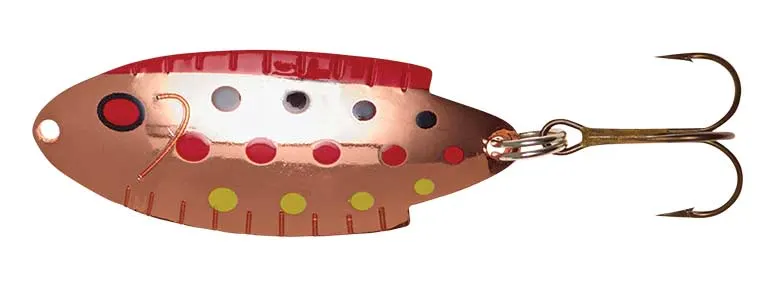
The Thomas Lures Buoyant Spoon is a go-to lure for brown trout. Gregory Reid
A rise in water and a good staining prompts browns to slide out of tucked-up structure and back to midriver feeding lanes. Suddenly, covering wide swaths of water becomes essential, and a spoon does this well. While I’ve used several spoons for this task, a Thomas Buoyant has always been a favorite because its unique fins and wide profile produce more flash, better swimming action, and more vibration than many others. Although a straight retrieve will get browns to attack, I tend to adopt more of a steelhead swing tactic, firing across a likely run, keeping the rod tip high, and twitching the spoon as it sweeps across the current. The hit usually comes just before the spoon straightens out in the heaviest part of the flow. By casting short first and then increasing distance, you can effectively cover a run without moving. On smaller streams with fairly dense cover, a spoon also shines because you can easily skip-cast it under low-hanging limbs or brush.
Luhr-Jensen Krocodile Spoon – Target: Striped Bass
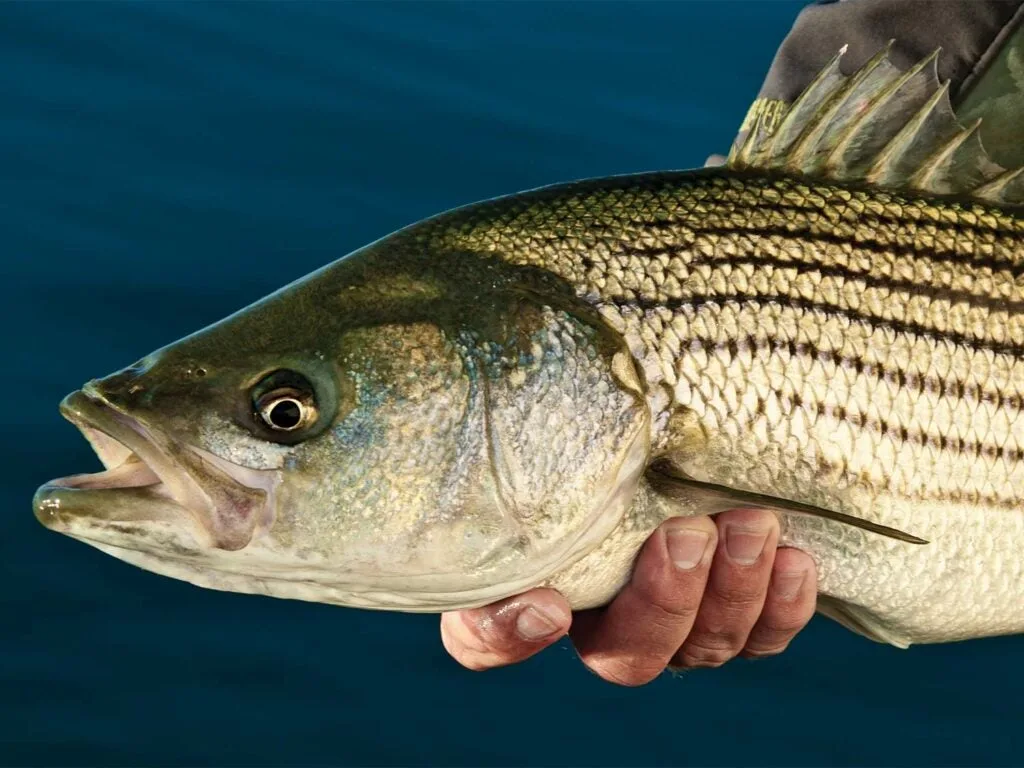
Load your striper box with lures during the fall run. Tosh Brown
There are hundreds of metal lures that have become staples for salty anglers across the globe, from the Hopkins and the Kastmaster that you can launch a mile, to the light, sharp-angled Clarkspoon that’s been trolling up everything from tuna to king mackerel to dolphin since 1927. Favorite spoons will naturally vary by region and species, but if you chase striped bass anywhere from Maine to Virginia, there’s a strong possibility you’ve got some Krocodile Spoons in an array of sizes stashed among your lure collection.
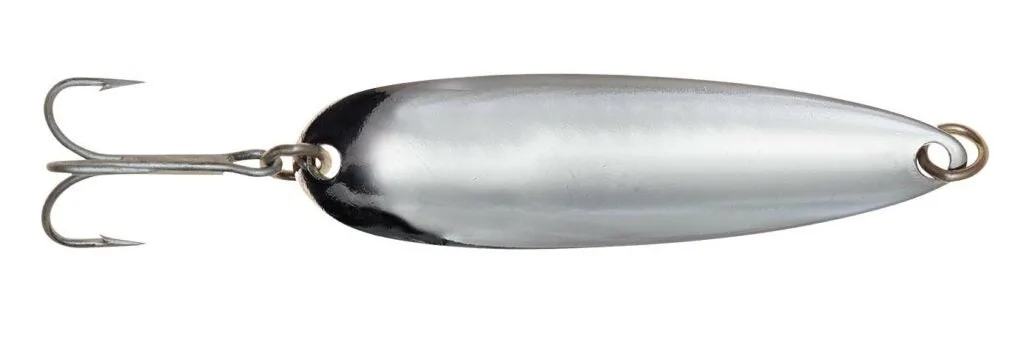
The Luhr-Jensen Krocodile Spoon is a saltwater staple. Gregory Reid
Originally developed on the West Coast for species like salmon, halibut, and calico bass, the “Kroc” Spoon found a permanent home in the East when anglers realized it shines when jigged in shallower inshore water where stripers like to feed. A key feature of the Krocodile is that it’s slightly thicker than many other spoons, but because it maintains a traditional tapered spoon shape, a 3⁄4-ounce Krocodile doesn’t fall as fast as a 3⁄4-ounce jighead or slab-style metal. It’s as though these spoons have the perfect drop rate—not too slow and not too fast. Factor in a very pronounced flutter and flash, and the Kroc becomes particularly deadly when stripers are homed in on sea herring schools holding midcolumn later in the fall and into early winter. I’ve been out on party boats several times where if you didn’t have a Kroc, at best you were getting outfished 5 to 1, or at worst you weren’t catching any stripers at all. Drop down a few sizes, and a smaller Kroc Spoon is just as killer when bass are feeding on sand eels, mullet, or peanut bunker earlier in the fall season.
The beauty of a Krocodile is that it can be finessed more easily than other spoons and metals, thanks again to its wider profile creating a lot of water resistance to slow the fall. One of the most effective ways to capitalize on this action is to lift your rod high and fast when you jig, and then follow the slack line back to the water’s surface with the rod tip. The Kroc’s action is ramped up even more when you execute this technique with a slower, old-school fiberglass rod. I like to keep a finger on my line during that drop. Any tick or stop you feel, swing away.
Silver Streak Spoon – Target: Walleyes
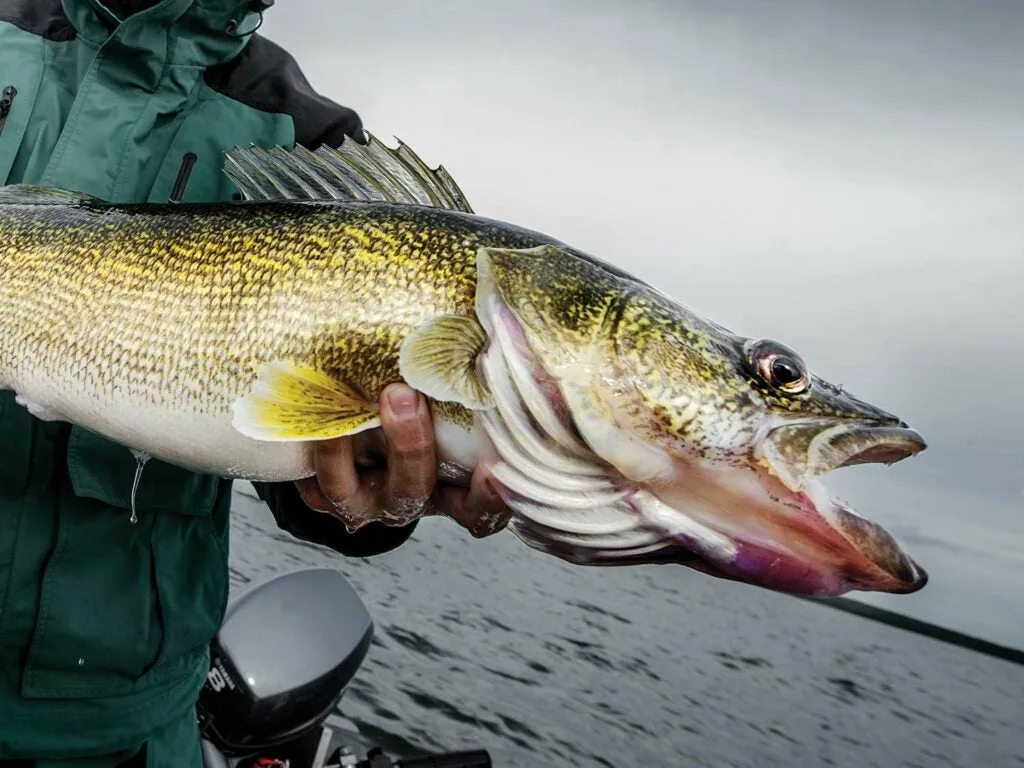
Spoons let you cover a lot of walleye water effectively in the fall. Lee Thomas Kjos/The Raw Spirit
Veteran Lake Erie guide Ross Robertson knows that as water temperatures begin to crash in the fall, the chill down is going to get forage species like emerald shiners, small white bass, yellow perch, and smelt grouped up. This is both a blessing and a curse for anglers, because you often have to cover lots of water until you find a massive cloud of bait on your sonar. But when you find it, you’ll have also found walleyes, and although there’s a ton of tactics that can catch the fish in these tight bait schools, Robertson says it’s very hard to beat a simple spoon.
“A fluttering trolling spoon is a do-all, catch-all kind of lure,” he says. “There’s really no way to mess it up, provided you pay attention to how you rig it.”

The Silver Streak Spoon has a fluttering motion that brings in trophy walleyes. Gregory Reid
Robertson says that many anglers believe a spoon should be rotating like an inline spinner blade, but that’s not the case. Flutter spoons are supposed to flop from side to side. It’s a delicate action that he says will be instantly marred by tipping the spoon with any kind of bait or soft plastic, or connecting it to the leader via a snap swivel. Likewise, fishermen have a nasty habit of changing the hooks on their spoons without considering how a weight or size increase or decrease can unbalance the lure and rob it of its action.
“I use just a very small snap to connect my spoon to a 20-pound fluorocarbon leader,” Robertson says. “You also don’t want to use a leader any shorter than 5 feet or any longer than 7. That’s critical when pairing spoons with diving devices. You catch a lot of fish on inside turns when the spoon doesn’t have a lot of force put on it from the boat, so you’re relying on your dipsy or jet diver to impart action. If your leader is too long, that spoon will just be hanging there like a sack of potatoes not doing anything.”
During the fall, Robertson keeps a massive spoon arsenal on his boat, but he finds himself reaching for a Silver Streak more than any other. Not only are they available in a vast array of colors, but also, he says, their paint jobs won’t wear off even after seasons of walleye abuse.
Clam Leech Flutter Spoon – Target: Crappies
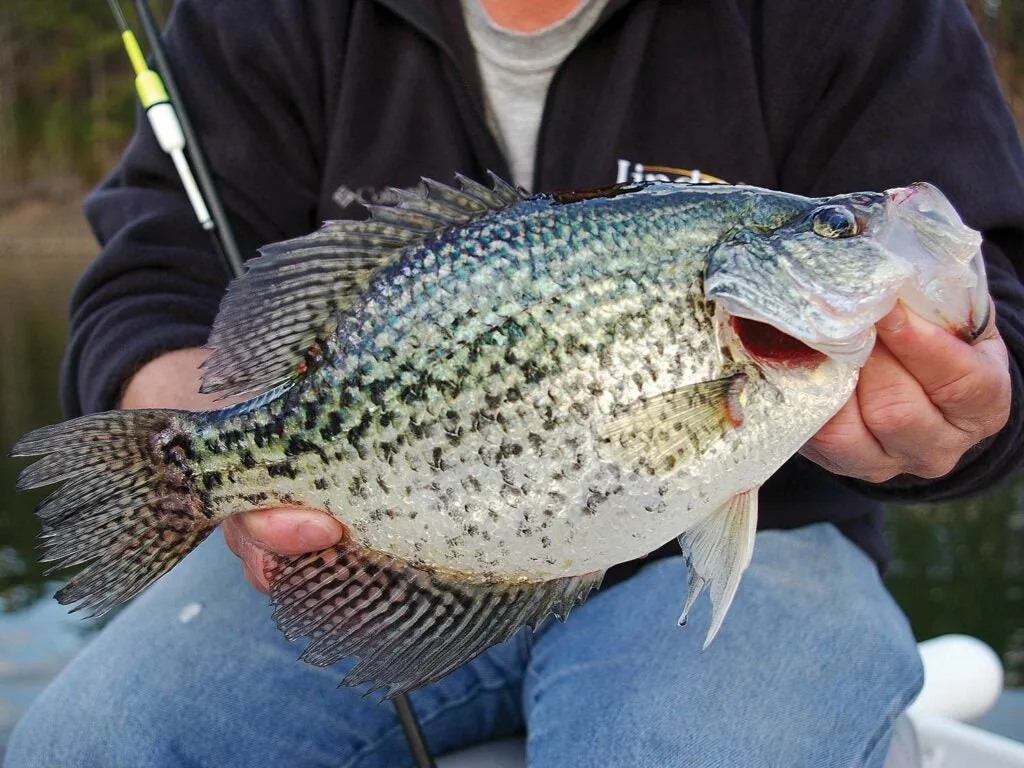
An angler shows of a slab of a fall crappie. Keith Sutton
Lake turnover in fall frustrates a lot of anglers. Just when you were dialed in to a late-summer pattern, the fish vamoose from where they’ve been posted up for the past few months. For New Hampshire–based guide Tim Moore, on the other hand, turnover is a welcome change. On Lake Winnipesaukee, his home waters, turnover in early October gets the crappies out of shallow structure and schooling up in deep basins and depressions. This makes them easier to find, but not always easy to feed. Moore says a spoon really helps.
“Sometimes you’ll mark a little clutter on the bottom,” he says. “That’s typically a school that isn’t feeding. But if you drop a spoon into them and work it aggressively, if you manage to get just a couple of those fish interested, you can get the whole school suspended and feeding.”

The Clam Leech Flutter Spoon is a go-to bait for crappier anglers. Gregory Reid
Ideally, Moore wants to mark schools higher in the column, because they’re the active eaters. Suspended fish are also roving, so the trick is to try to drift with them and move around to stay with the school. According to Moore, when you’re in suspended fish, you can literally let your spoon just dangle. The slight flutter created by the drifting boat is enough to get the crappies piling on, and he’s noticed that a Leech Flutter Spoon in gold gets them piling on extra hard.
“If for some reason a vertical presentation isn’t working, start casting,” Moore says. “Go long, let the spoon hit the bottom, and reel back steadily. Sometimes this presentation catches more fish, but it also helps you locate schools around the boat that your sonar might not see. If you catch fish farther out, move in that direction.”
Heavy-Metal Homemaker
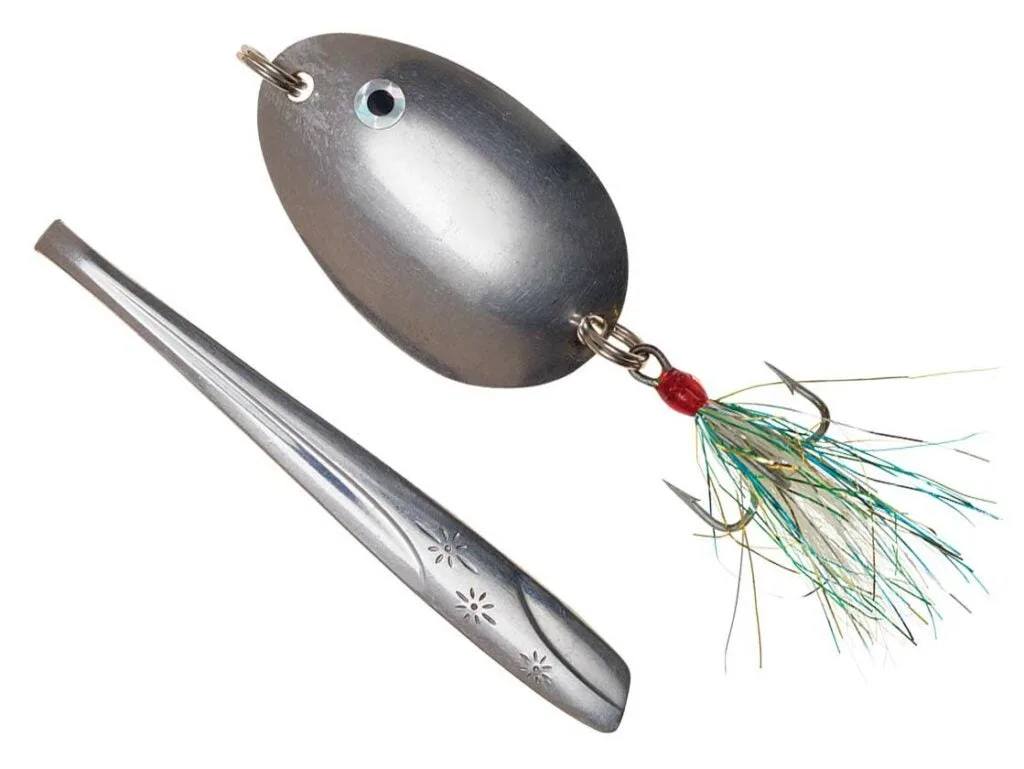
You can make a killer spoon lure from, well, an actual spoon. Gregory Reid
If you (or you and the kids) need a fun project, it’s fair to say that there’s not an easier, more effective lure you can build at home than a spoon. If you don’t have some old silverware sitting around, a visit to a flea market, thrift shop, or antiques store is in order. And unless the spoons you find happen to have been used on the Titanic, you can expect to pay less than a buck apiece for them. As kitchen spoons come in all shapes, sizes, and depths, experimentation possibilities are almost endless. Once you cut off the stem and file the connection point smooth, you’ve got a blank canvas.
The cool part is that no matter how simple or snazzy you make your spoon, it’ll catch fish. Just drill a hole in each end, add split rings and a hook, and fire away. Or get creative by hammering in scale patterns or adding paint, holographic tape, eyes, and a hook dressed with Mylar or bucktail. For a video tutorial on making a spoon, visit fieldandstream.com/spoonproject.
Red, White, and Blood?
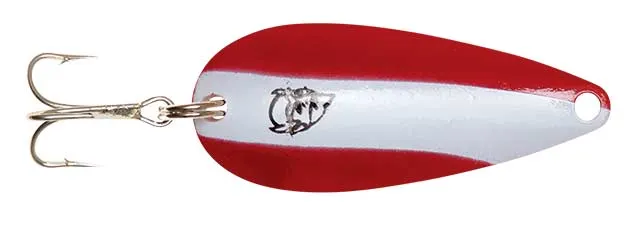
How did this iconic spoon lure get its color pattern? Gregory Reid
John Cleveland of Eppinger MFG says when the red-and-white Dardevle Spoon was created in the early 1900s, there was no science behind the color. “It was an experiment,” he says. “I’ve heard everything from the red representing blood to the white stripe representing a pork strip. But they’re just stories.” Cleveland believes the color combo simply creates contrast that triggers strikes. And thanks to the Dardevle, red-and-white remains a common pattern on all sorts of lures.

